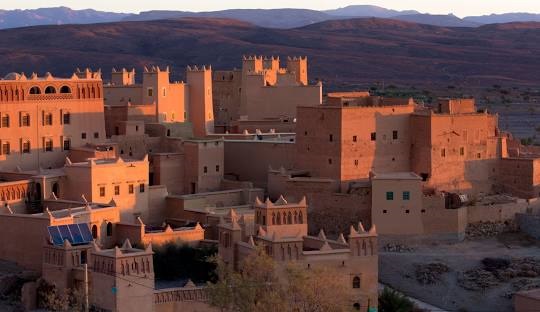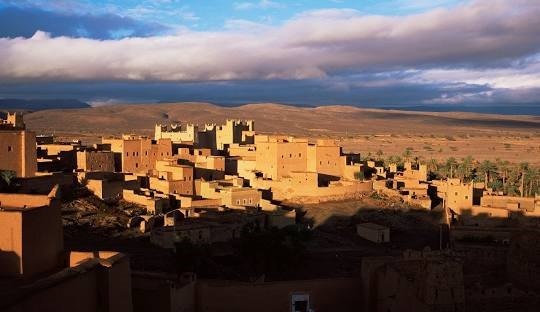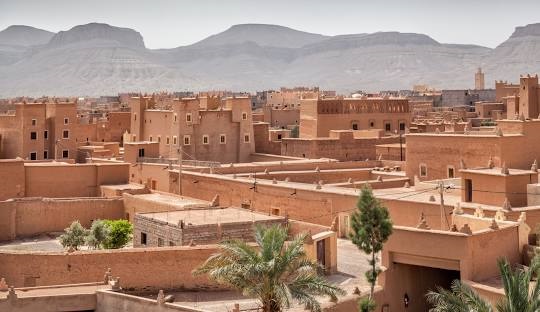Nkoub, home to Riad Nkob, is a small, charming village located in the southeastern part of Morocco, nestled at the foot of the Saghro Mountains. This quaint village, with its rich cultural heritage, stunning landscapes, and traditional Berber architecture, provides a fascinating glimpse into the lives of the indigenous Berber people who have called this region home for centuries.
Nkoub
Despite its relatively remote location, Nkoub has become a noteworthy destination for travelers seeking an authentic experience of Morocco’s southern desert region, offering a mix of natural beauty, cultural richness, and historical significance. Nkoub is located in the Draa Valley, an area known for its palm groves, ancient fortified homes, and dramatic desert scenery.
The village sits approximately halfway between the larger towns of Ouarzazate to the north and Zagora to the south, making it a convenient stop for travelers exploring the Draa Valley and the surrounding regions. It is also a gateway to the Jbel Saghro mountains to the east, providing access to some of Morocco’s most stunning and remote landscapes.
The landscape surrounding Nkoub is characterized by rugged mountains, vast plateaus, and arid deserts, interspersed with lush oases fed by underground springs. These oases are vital to the local economy and way of life, providing water for agriculture and supporting a diverse range of plant and animal life. The combination of harsh desert conditions and fertile oases creates a unique and beautiful environment that is typical of southern Morocco.
Nkoub experiences a semi-arid climate, typical of the broader Draa Valley region. The summers are hot, with temperatures often exceeding 40°C during the peak of the season, while winters can be quite cool, particularly at night, with temperatures occasionally dropping close to freezing. Rainfall is scarce and sporadic, usually occurring in short bursts that can lead to flash floods in the nearby mountains and valleys.
Despite the harsh conditions, the local Berber communities have adapted well to the climate, utilizing traditional methods of water conservation and irrigation to make the most of the limited resources available. Nkoub has a rich history that is deeply intertwined with the history of the Berber people, who are indigenous to North Africa and have inhabited this region for thousands of years.
The village is traditionally inhabited by members of the Aït Atta tribe, a semi-nomadic Berber tribe known for their pastoral lifestyle and deep connection to the land. The Aït Atta are renowned for their fierce independence and resilience, having resisted numerous invasions and attempts at colonization throughout history.
The history of Nkoub is reflected in its architecture, particularly in the many traditional fortified homes that dot the village and its surroundings. These are built from local materials such as mud bricks and stones, designed to withstand the harsh desert environment while providing security and comfort for their inhabitants.
Many of these fortified homes are still inhabited today, while others have been converted into guesthouses or cultural centers, offering visitors a chance to experience traditional Berber architecture and hospitality firsthand. One of the most significant historical events in the region was the Aït Atta resistance against the French colonial forces in the early 20th century.
The Aït Atta’s resistance culminated in the Battle of Bou Gafer in 1933, where the tribe, under the leadership of Assou Oubasslam, made a last stand against the French in the rugged terrain of the Jbel Saghro mountains. This event is still remembered today as a symbol of Berber resistance and pride and is an important part of the cultural identity of Nkoub and the surrounding region.
Nkoub is famous for its numerous fortified villages, which are a defining feature of the area and its surroundings. These Berber buildings are constructed from a mix of mud, straw, and stones, using techniques that have been passed down through generations. The thick walls of the fortified villages are designed to keep the interiors cool in the sweltering summer heat and retain warmth during the colder months, making them ideally suited to the climate.
The fortified villages of Nkoub are not just architectural marvels but also serve as a testament to the area’s rich cultural heritage. Many of these structures have been standing for centuries and have been carefully maintained by local families who continue to live in them. Each fortified village has its own unique history and story, often passed down through generations.
These are often located on hilltops or along ridges, strategically positioned to provide defense against potential invaders and to take advantage of the natural resources in the area. The fortresses of Nkoub, with their maze-like alleys, ancient walls, and communal spaces, offer a glimpse into the social and communal life of the Berber people who have lived in this region for centuries.
The economy of Nkoub is primarily based on agriculture, livestock rearing, and, increasingly, tourism. The fertile oases surrounding the village allow for the cultivation of a variety of crops, including dates, almonds, and cereals, which are the mainstay of the local diet and economy. Traditional irrigation systems, are used to channel water from underground sources to the fields, allowing for the sustainable use of limited water resources.
Livestock rearing, particularly goats and sheep, is an important part of the local economy. The semi-nomadic lifestyle of the Aït Atta tribe, which involves moving livestock between different grazing areas depending on the season, has allowed the community to make the most of the scarce resources in the region.
This traditional way of life is still practiced by many in Nkoub today, although it is increasingly being supplemented by other economic activities, such as handicrafts and tourism, which has become an increasingly important part of the economy in recent years, as more travelers discover the unique beauty and cultural richness of Nkoub and the surrounding region.
The village’s traditional architecture, stunning landscapes, and authentic Berber culture have made it a popular destination for those seeking an off-the-beaten-path experience in Morocco. Local guides and guesthouses offer a range of activities for visitors, including trekking in the nearby Jbel Saghro mountains, visiting traditional fortified villages, and learning about the local way of life through cultural experiences and workshops.
Nkoub’s location at the foot of the Jbel Saghro mountains makes it an ideal base for trekking and adventure tourism. The range, with its rugged peaks, deep gorges, and dramatic rock formations, offers some of the most spectacular trekking opportunities in Morocco. Several well-established trekking routes start from Nkoub, ranging from short day hikes to multi-day expeditions that take trekkers deep into the heart of the mountains.
One of the most popular trekking routes in the area is the Jbel Saghro traverse, a multi-day trek that crosses the range from north to south, passing through remote villages, dramatic landscapes, and ancient fortified villages. This trek offers a unique opportunity to experience the stunning beauty of the region and learn about the traditional way of life of the local Berber communities.
Along the way, trekkers have the chance to stay in traditional guesthouses, enjoy local cuisine, and experience the legendary hospitality of the Berber people. In addition to trekking, Nkoub also offers a range of other outdoor activities, including rock climbing, mountain biking, and 4×4 tours. The region’s rugged terrain and stunning landscapes make it a paradise for outdoor enthusiasts.
On the other hand, its remote location ensures a sense of solitude and adventure that is increasingly hard to find in more popular tourist destinations. Nkoub is not just a destination for adventure seekers, but also offers a wealth of cultural experiences for those interested in learning more about the rich heritage of the Berber people.
The village is home to several cultural centers and workshops that offer visitors the chance to learn about traditional Berber crafts, such as weaving, pottery, and jewelry making. These workshops provide a unique insight into the skills and techniques that have been passed down through generations and allow visitors to take home a piece of Nkoub’s rich cultural heritage.
Visitors to Nkoub have the opportunity to witness traditional Berber music and dance performances. They can also participate in local rituals and customs, and experience the vibrant culture of the Aït Atta tribe firsthand. Nkoub is a hidden gem in southern Morocco, a place where ancient traditions and stunning natural beauty come together to create a unique and unforgettable experience for visitors.
Whether trekking through the rugged mountains of Jbel Saghro, exploring the ancient fortified villages that dot the landscape, or immersing oneself in the rich cultural heritage of the Berber people, Nkoub offers something for everyone. For those seeking an authentic and off-the-beaten-path adventure in Morocco, Nkoub is a destination that should not be missed.



